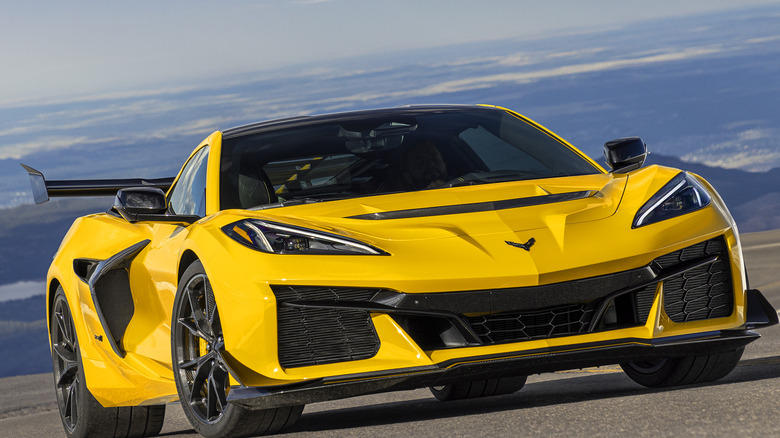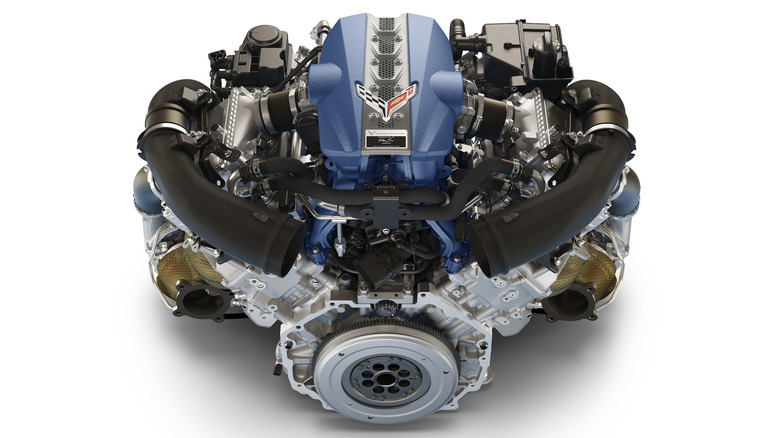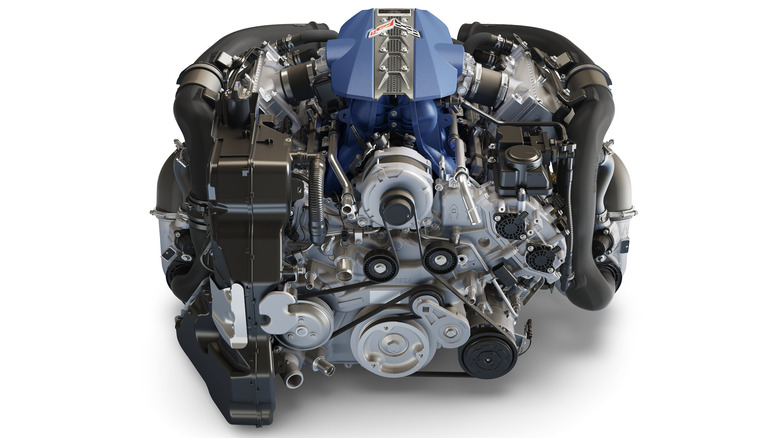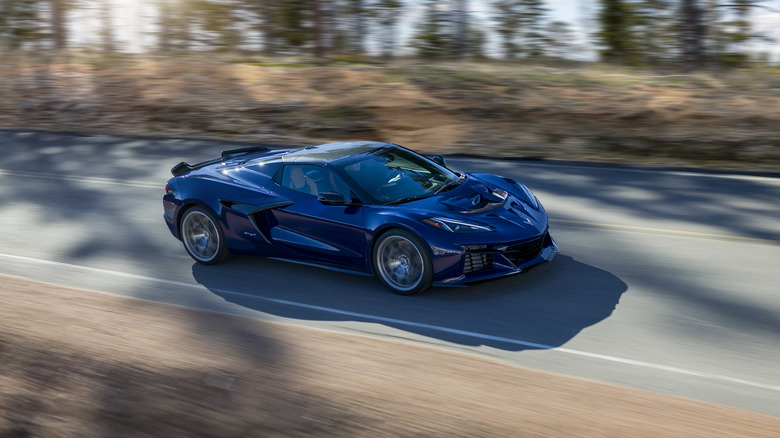
Chevrolet
While we’ve known for a while that Chevrolet was bringing back the ZR1 in 2025, the automaker had been keeping details about the highly-anticipated sports car close to the vest — until now. Chevy has introduced the 2025 ZR1, revealing jaw-dropping specs and the return of a split window design. Before we knew much about the forthcoming model, SlashGear drafted a wish list of things we wanted to see in the 2025 Corvette ZR1, and at the top of that list was an upgraded V8 engine. Chevrolet has delivered, as the new Corvette will come equipped with the most powerful V8 ever produced in America from an auto manufacturer.
Dubbed the LT7, the Corvette’s new beast of an engine is a 5.5-liter, twin-turbocharged DOHC flat-plane crank V8, and is available for both the coupe and convertible trims of the ZR1. «The team that revolutionized Corvette with a mid-engine architecture took on another challenge: take ZR1 to the next level,» said Scott Bell, vice president, Chevrolet. «Corvette ZR1 is about pushing the envelope with raw power and cutting-edge innovation. From Stingray, to Z06, E-Ray, and now ZR1, the Corvette family continues to elevate with each new iteration — and challenge the best in the world.»
Chevrolet’s engineers built upon the LT6 and added new unique designs that make the LT7 — and the 2025 Corvette ZR1 — a force to be reckoned with. Here’s everything Chevy fans need to know about the new LT7 Twin-Turbocharged 5.5L DOHC VVT DI, including its state-of-the-art architectural designs and the eye-popping speed and horsepower it can deliver to the ZR1.
Twin turbochargers are a factory Corvette first

Chevrolet
While the architecture of the LT7 evolves directly from the Corvette Z06’s LT6 engine, which was the most powerful naturally-aspirated production V8 ever built, the addition of twin turbochargers makes the ZR1 a whole other animal. In fact, this marks the first time a factory Corvette has ever sported twin turbochargers. Don’t think of the LT7 as an LT6 with turbochargers grafted on, however — the engine was rebuilt and optimized from the ground up so that every system could work in tandem with and take advantage of the forced induction devices.
The LT7 Twin-Turbo V8 pushes the boundaries of its engine architecture to produce optimal performance from the combination of forced induction and a 5.5-liter flat-plane crank. Several features that are unique to the LT7 help make it the powerhouse that is. These include a completely new intake system tuned for twin turbochargers; head castings with unique ports and a larger combustion chamber; a CNC-machined combustion chamber, exhaust, and intake ports specific to the LT7; valve train timing and a lift profile optimized for forced induction with higher exhaust temp enabling exhaust valves; and intelligent anti-lag engine calibration techniques crafted specifically for the ZR1 that adapt and react to driving style. Additionally, dual, ported shroud, ball bearing, mono-scroll (76 mm) turbochargers have been integrated with the exhaust manifold to reduce the volume and distance from the exhaust valve to the turbine wheel for a quicker response with electronic wastegates.
The ZR1’s transmission was upgraded to keep up with the new V8’s performance

Chevrolet
Chevrolet’s engineers also made several alterations to the Corvette ZR1’s transmission so that it could work in tandem with the new LT7 Twin-Turbo V8 engine. Upgrades were made to the eight-speed dual-clutch transmission’s inner and outer input shafts. Additionally, its gear capacity was improved with increased strength via shot peening for all eight gears. Other changes to the transmission made by the Chevy team include final drive refinements, oil management to support increased vehicle longitudinal and lateral capability, and increased control valves to accommodate the higher required clutch clamp load for the new engine.
The LT7 Twin-Turbocharged 5.5L DOHC VVT DI differs from its predecessor in other ways, as well. Compared to the LT6, the LT7 also has added block and head machining to support turbo cooling and oiling, counterweight changes to account for a unique piston, a unique connecting rod for the crank train, and a secondary port fuel injection system to deliver additional fuel needed to support the engine’s jaw-dropping output.
The LT7 can produce more power than any manufacturer-made V8 in America

Chevrolet
When SlashGear was able to get behind the wheel of the 2019 ZR1, its 755-horsepower engine «roared down the straight.» The new LT7 Twin-Turbocharged 5.5L DOHC VVT DI ups the ante by producing 1,064 horsepower at 7,000 rpm and 828 lb-ft of torque at 6,000 rpm — making it the most powerful V8 ever produced in America from an auto manufacturer and delivering the most power ever from a factory Corvette. It produces more power than two LS7 engines — the 7.0L V8 from the sixth-generation Corvette Z06 — so the 2025 ZR1 is basically running with one LS7 engine per bank. Paired with a carbon fiber aero package, the V8 can help create over 1,200 pounds of downforce at top speed.
How fast can the 2025 Corvette ZR1 go? With the new LT7 under its hood, the vehicle made a sub-10-second quarter-mile time in its very first launch. Four test drivers exceeded 200 mph peak speed on their very list laps at the Nürburgring, and on its first lap at the Milford Proving Ground’s MRC test track, the ZR1 also clocked a faster peak speed than the production C7 ZR1. At its fastest, the new Corvette reached a top speed of over 215 mph.
The LT7 Twin-Turbocharged 5.5L DOHC VVT DI will be hand-assembled by master engine builders at Chevrolet’s Performance Build Center, part of the Bowling Green Assembly Plant in Kentucky. Chevy fans will soon be able to experience its four-figure horsepower capabilities when the 2025 Corvette ZR1 begins production later this year.